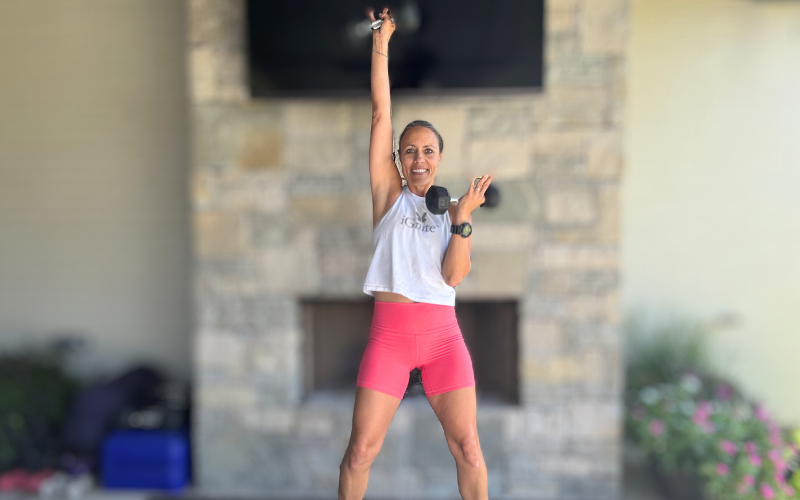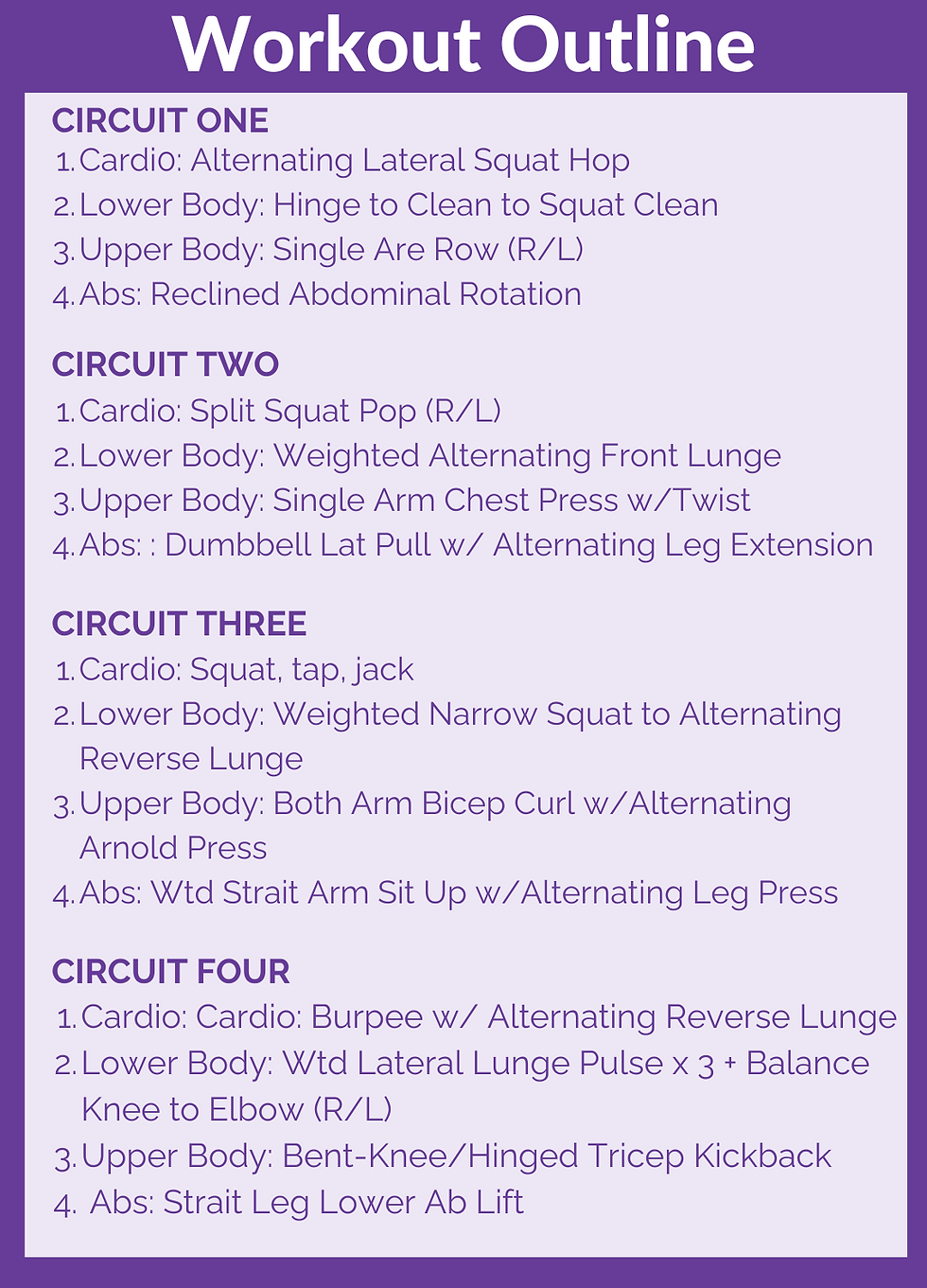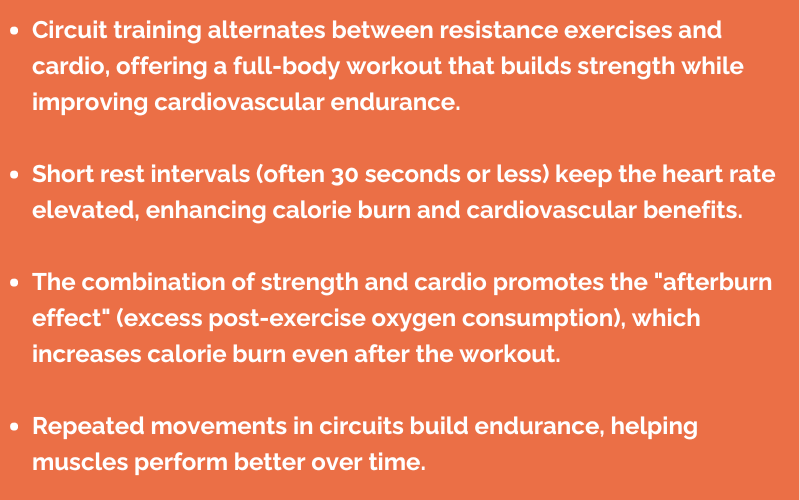
We love a circuit class, especially when it incorporates cardio and full body strength! While using dumbbells only, you'll work through four circuits with four exercises per circuit: cardio, upper body strength, lower body strength and abdominal strength. If you're short on time, cut the workout in half and only perform the first two circuits, last two circuits or only one. Either way, in this at home circuit workout, you'll get good and sweaty, burn calories and build muscular strength and cardiovascular endurance!
5 Benefits of an At Home Circuit Workout
Minimal Equipment Needed: Most circuits can be done with minimal equipment or body weight, making them accessible and versatile.
Increased Calorie Burn: The combination of continuous movement and engaging multiple muscle groups burns more calories during the workout and boosts metabolism afterward.
Improved Cardiovascular Fitness: Incorporating cardio-based movements keeps the heart rate elevated, enhancing endurance and cardiovascular health.
Enhanced Strength and Endurance: Alternating between strength and endurance exercises improves both muscle power and stamina simultaneously.
Balanced Muscle Development: By targeting all major muscle groups, full-body circuits ensure balanced strength and reduce the risk of muscle imbalances.
At Home Circuit Workout Equipment
Medium Pair of Dumbbells
I like having a variety of dumbbells- heavier for lower body and a little lighter for upper body. I used a range of between 8 and 20 pounds in this At Home Circuit Workout.
Workout Instructions
Your At Home Circuit Workout Looks like this
4 Circuits
4 Exercises per Circuit (cardio, lower body strength, upper body strength and abdominal strength)
Timed Intervals (perform each exercise 40 seconds, then rest 20 seconds)
Repeat each circuit X 2 sets


1. Split Squat Pop
Targets: Quads and Glutes
How to Do a Split Squat Pop Correctly
Stand with your feet staggered, one foot in front of the other, about hip-width apart.
Keep your front knee aligned over your ankle and your back foot resting on the ball of your foot.
Engage your core and keep your chest upright.
Lower your body into a lunge position by bending both knees.
Your back knee should hover just above the floor, and your front thigh should be parallel to the ground.
Keep your front knee directly above your ankle and avoid letting it go past your toes.
Push through both feet, jumping straight up as high as you can.
Land softly with your knees slightly bent to absorb the impact.
Immediately lower into another split squat and repeat the jump, alternating legs with each jump.
2. Alternating Front Lunge
Targets: Quads, hamstrings, glutes, and core while improving balance, coordination, and lower-body strength.
How to Do an Alternating Front Lunge Correctly
Stand tall with your feet hip-width apart.
Engage your core, keep your chest up, and maintain a neutral spine.
Take a big step forward with your right foot.
As you step, lower your hips and bend both knees to 90 degrees.
Your back knee should hover just above the ground, and your front thigh should be parallel to the floor.
Make sure your front knee is aligned directly over your ankle and not going past your toes.
Press through your front heel and step back to the starting position, bringing your feet together.
Repeat on the opposite leg and step forward with your left foot and repeat the lunge motion.
Keep your torso upright and avoid leaning forward.
Engage your core throughout the movement to maintain balance.
Ensure your knees track straight and don’t cave inward.
Continue alternating and repeat the movement, alternating between your right and left leg with each step.
3. Single Arm Chest Press Internal Rotation
Targets: Chest/pecs, shoulders, and triceps while the internal rotation adds a functional twist to engage stabilizing muscles and improve shoulder mobility
How to Do a Single Arm Chest Press with Internal Rotation Correctly
Lie flat on your back with your knees bent, feet flat on the floor for stability and glutes raised.
Hold a dumbbell in one hand (your working arm) with your elbow bent at a 90-degree angle, palm facing inward (neutral grip).
Extend your free arm up (for added balance, place it on the ground)
Press the dumbbell upward by straightening your arm while rotating your palm inward so that it faces your opposite shoulder at the top of the movement.
The internal rotation should occur smoothly as you press, not forcing the rotation but following the natural range of motion.
At the top of the press, your arm should be fully extended, with the dumbbell directly above your chest and your palm facing inward (toward your midline).
Slowly lower the dumbbell back down, reversing the rotation so your palm returns to the neutral position at the bottom.
Keep your elbow at about 45 degrees to your body during the descent (not flared out wide).
Engage your core and maintain a stable body throughout the movement to avoid twisting.
Control the movement through the entire range of motion—avoid jerky or fast movements.
4. Supine Dumbbell Lat Pull with Alternating Leg Press
Targets: Latissimus dorsi (lats), core, and lower body, improving strength and stability while also engaging coordination.
How to Do an Alternating Front Lunge Correctly
Lie flat on your back (supine) on a mat with your knees bent at a 90-degree angle and feet off the floor.
Hold a dumbbell in both hands, arms extended above heart, toward the ceiling, with your palms facing each other (neutral grip).
Engage your core, keeping your lower back pressed firmly against the mat.
Keeping your arms straight (slight bend in elbows), lower the dumbbell slowly behind your head until it almost touches the floor.
This movement should engage your lats, chest, and shoulders.
As you lower the dumbbell, simultaneously extend one leg out, pressing it straight without touching the floor. Keep the other leg bent at 90 degrees.
Return to Start Position:
Bring the dumbbell back up to the starting position over your chest as you return your extended leg to the bent 90-degree position.
Engage your core to maintain stability throughout the movement.
Repeat the same movement, extending the opposite leg while lowering the dumbbell behind your head.









Comentarios